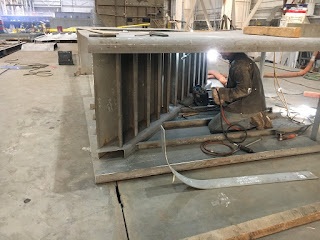 |
| Ferry Madonna, constructed with hull inverted, taken bow-on. (Rich Ellefson photo) |
Detroit Harbor, Washington Island -
Photos shown in this posting were taken by Ferry Line VP Rich Ellefson Monday and Tuesday of this week, and they indicate significant overall progress once again.
In the shot below, Rich stood on the bottom, straddling the keel and looking forward.

The bow shape is now well-defined and soon should be completely plated over.
 |
| Hull plating of 1/2-inch thickness is being added here to the framed bow section. Yellow cube is a weight suspended from overhead crane used to flatten shell plate until it can be welded to frames. |
Shown below that photo is one of the engine room overhead. Pipes, or stanchions, help support the main deck overhead while taking up minimal space around machinery and piping. A ladder for crew access to the machinery space is shown resting in its approximate location, not yet attached.


Bulwarks that will become vehicle deck enclosures, and the larger side curtains that also provide rigidity to the hull while supporting the superstructure above the main deck, are being fabricated separately. They'll be attached in location once the two hull halves are upright. With hull steelwork easier to complete in the present upside-down configuration, roll-over for the two hull halves has now been pushed back until January 6th.
Below that is a photo of the two rudder supports, heavy plates that project both aft and slightly outboard from each shaft centerline, so that propeller shafts can be inserted/removed from the vessel without removal of the rudders.
White cylinders are Thordon rudder bearings machined of a hard ceramic material that will accept and support each rudder's pintle, the lower end of the rudder. The final photo shows the two rudder stocks of heavy pipe that become the basis for each rudder plane. Above each rudder are the "palms," flat surfaces bolted together that make removal relatively easy in dry dock, should it be necessary to repair a rudder.



One final note apart from new ferry construction, and one not substantial enough to warrant a separate blog: the morning ferry today sailed to Gills Rock due to lake seas and surging at the Northport facility.
This is a a change of pace, certainly, and the second time in the past month when Gills Rock has been used as an outlet. This move creates confusion for travelers and some difficulties for our crews, too. Crew must deal with freight delivered to Northport. Tickets can't be sold at Gills Rock for lack of computer / printer there. Incoming traffic (without cash) wishing to use credit cards are asked to stop at our Island booth to make transactions AFTER arriving at the Island. So, it's a bit of a hassle, but only temporary.
Winds had dropped considerably by 10 a.m., with trips resuming to Northport by then. Later today the storm will have passed, and high pressure will cause an equally strong flow from the N/NW, with gusts predicted to reach 40 mph. That, too, may slow things down, with the possibility of overpowering winds and seas at Northport.
Happy Thanksgiving!
- Dick Purinton












